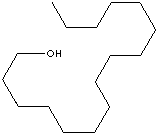| CETYL ALCOHOL
|
||
|
PRODUCT IDENTIFICATION |
||
| CAS NO. | 124-29-8, 36653-82-4 |
|
| EINECS NO. | 253-149-0, 253-149-0 | |
| FORMULA | CH3(CH2)15OH | |
| MOL WT. | 242.44 | |
| H.S. CODE | 2905.19 | |
|
TOXICITY |
Oral rat LD50: 5 gm/kg | |
| SYNONYMS | Hexadecan-1-ol; Palmityl alcohol; | |
| 1-Hexadecanol; Alcohol, C16; Cetanol; Hexadecyl alcohol; Cetylol; Hexadecanol; LorolL 24; Loxanol K; Product 308; Hexadécane-1-ol (French); | ||
|
SMILES |
|
|
|
CLASSIFICATION |
|
|
|
PHYSICAL AND CHEMICAL PROPERTIES |
||
| PHYSICAL STATE | white flakes | |
| MELTING POINT | 48 - 49 C | |
| BOILING POINT | 334 C | |
| SPECIFIC GRAVITY | 0.818 | |
| SOLUBILITY IN WATER | Insoluble | |
| pH |
|
|
| VAPOR DENSITY | 8.36 | |
| AUTOIGNITION |
|
|
| NFPA RATINGS | Health: 1; Flammability: 0; Reactivity: 0 | |
|
REFRACTIVE INDEX |
||
| FLASH POINT |
135 C |
|
| STABILITY | Stable under ordinary conditions | |
|
GENERAL DESCRIPTION AND APPLICATIONS |
||
Fatty alcohols, derived from natural fats and oils, are high molecular straight
chain primary alcohols. They include lauryl (C12), MyrIstyl (C14), Cetyl ( or
palmityl: C16), stearyl (C18), Oleyl (C18, unsaturated), and Linoleyl (C18,
polyunsaturated) alcohols. There are synthetic fatty alcohols equivalent
physically and chemically to natural alcohols obtained from oleochemical sources
such as coconut and palm kernel oil. Fatty alcohols are emulsifiers and
emollients to make skin smoother and prevent moisture loss. Identical fatty
esters are used to improve rub-out of formulas and to control viscosity and
dispersion characteristics in cosmetics, personal care products and
pharmaceutical ingredients. As chemical intermediates, the primary use of fatty
alcohols are as raw material for the production of fatty sulfate salts and
alcohol ethoxylates for foaming and cleaning purposes in the field of detergent
industry. Chemical reactions of primary alcohols include esterifications,
ethoxylation, sulfation, oxidation and many other reactions. Their derivatives
and end use applications include;
Large amount of fatty alcohols are used as special solvents, fillers in plasticizer and insulating materials for the building industry. Fatty alcohols are used as ingredients in the industries of agricultural, foodstuff, metal processing, cosmetics, lube additive, pharmaceutical, rubber, textile, perfume and flavouring as well as synthetic detergent. |
||
| SALES SPECIFICATION | ||
|
APPEARANCE |
white flakes | |
| MELTING POINT | 45 - 49 C | |
|
WATER |
0.1% max |
|
| IODINE VALUE |
1 max (I2 g/100g) |
|
| ACID VALUE | 0.2 max (mg KOH/g) | |
| SAP VALUE |
1 max (mg KOH/g) |
|
| HYDROXYL VALUE | 222 - 235 (mg KOH/g) | |
|
CARBON DISTRIBUTION |
C12: 1.0% max + C14: 3.0% max + C16: 95.0% min + C18: 3.0% max |
|
| TRANSPORTATION | ||
| PACKING | ||
| HAZARD CLASS | Not regulated | |
| UN NO. | ||
| OTHER INFORMATION | ||
| Hazard Symbols: XI, Risk Phrases: 36/37/38, Safety Phrases: 24/25-26-36/37/38
|
||
